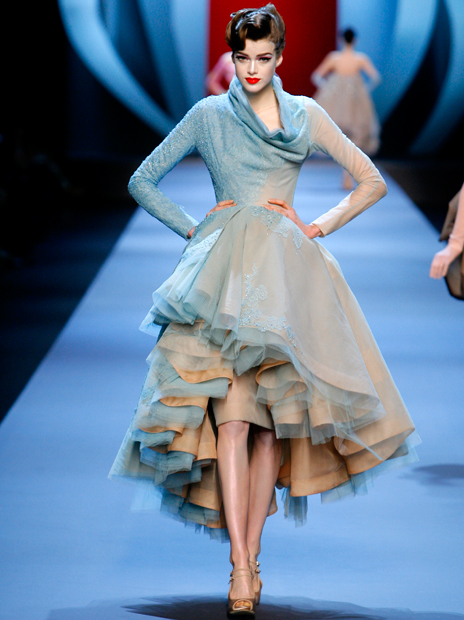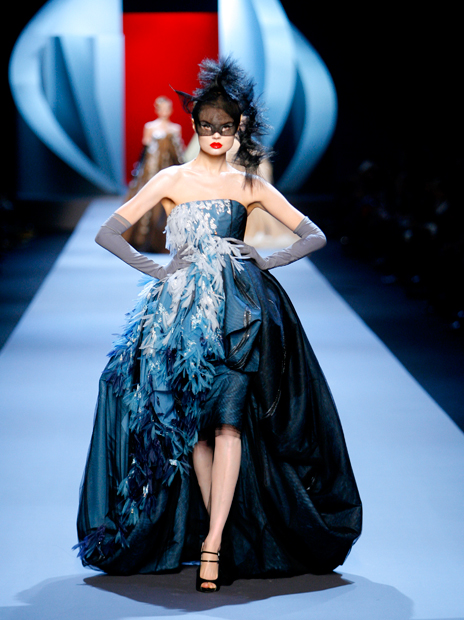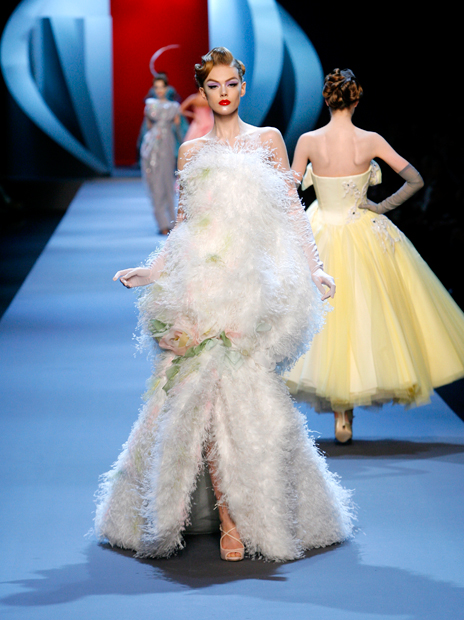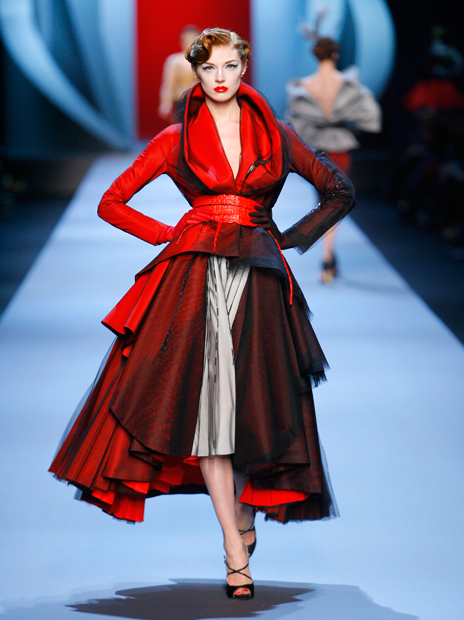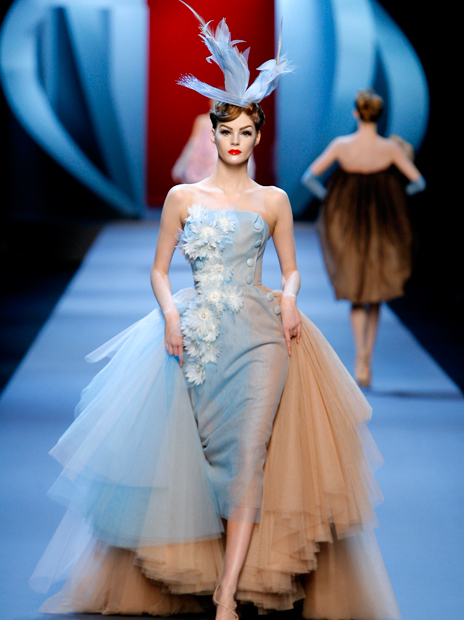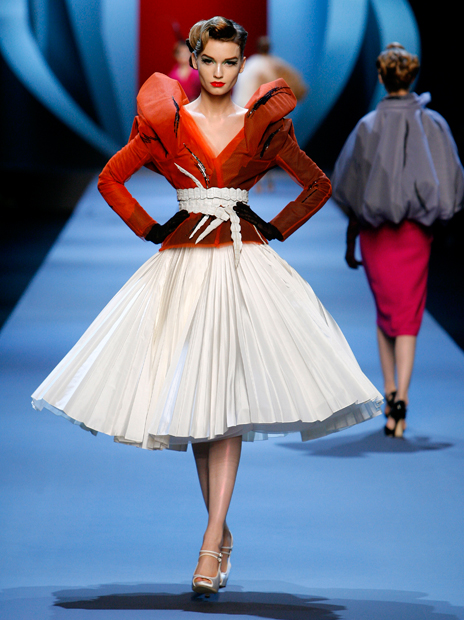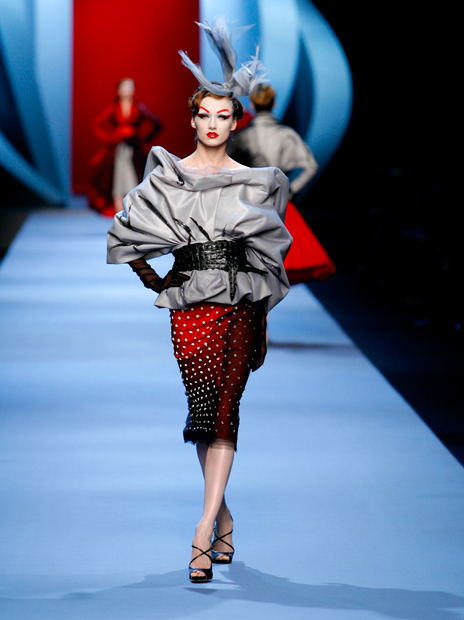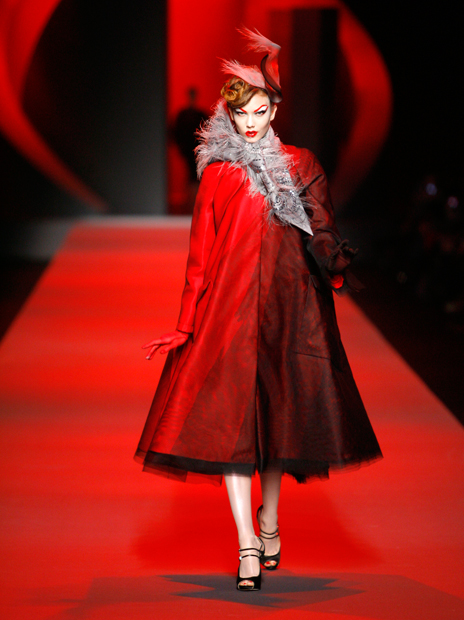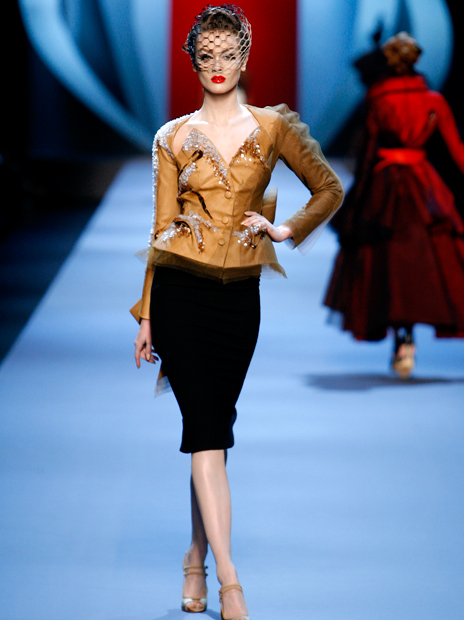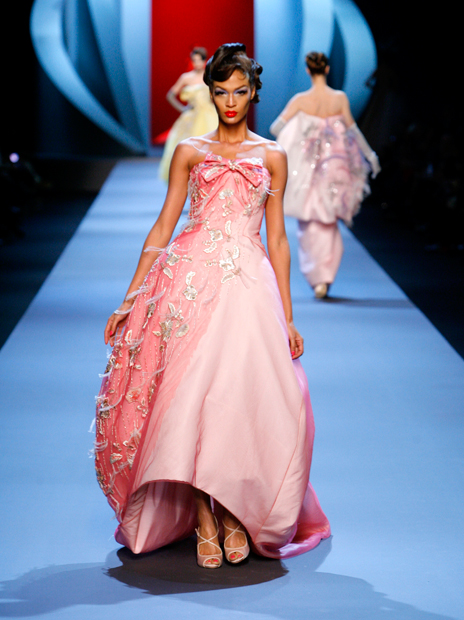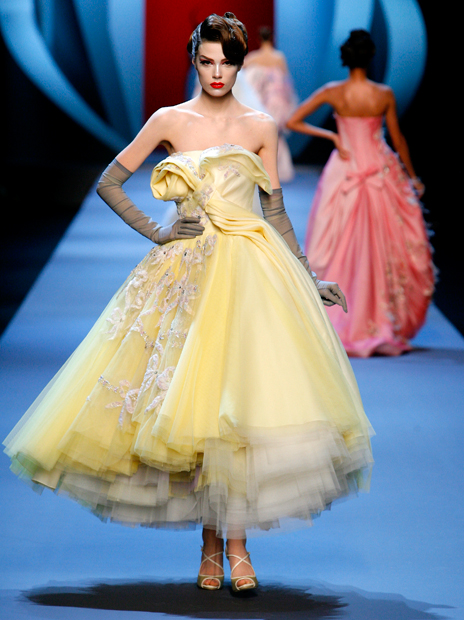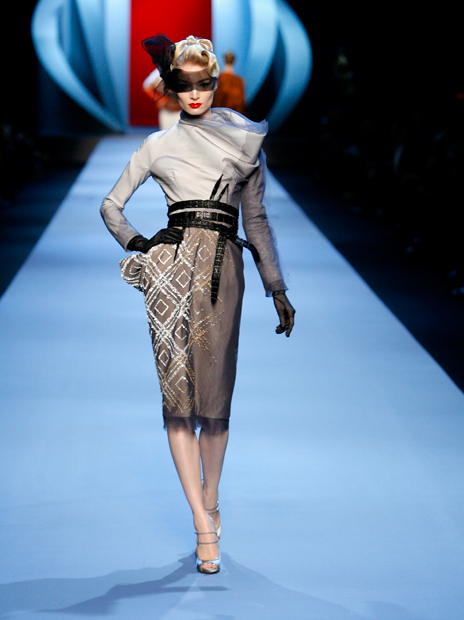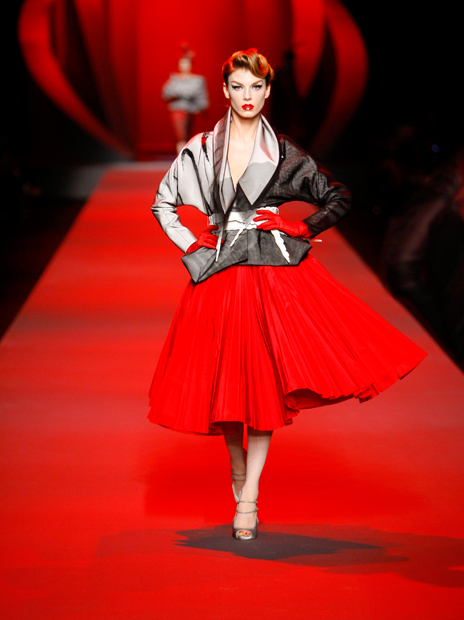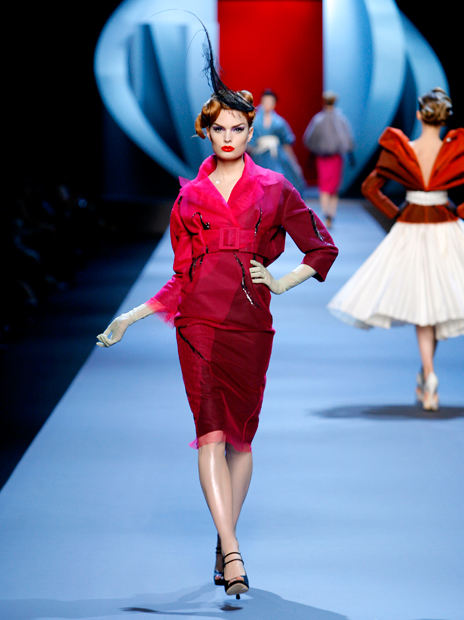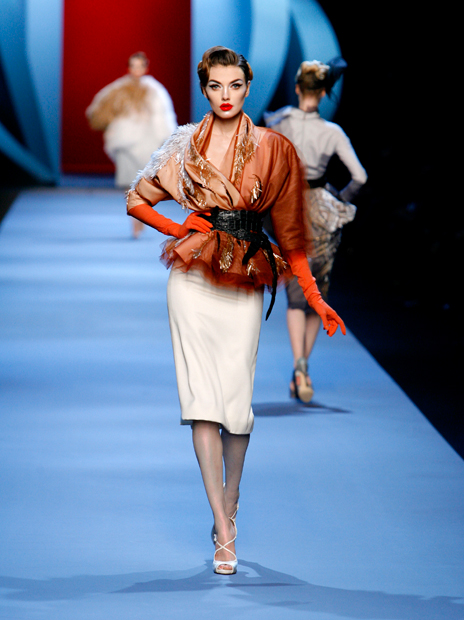Fashion is the pursuit of style through originality; two supremely difficult concepts to define that exist in fact almost entirely in the ether. Fashion, therefore, at times requires something approaching a leap of faith for one to believe in it. If fashion is a religion, then haute couture is its temple.
Glamour is the outcome whenever style and wealth occupy the same space. When the high priests of haute couture incandescently illuminate the runways, draping their extravagant otherworldly creations over the most beautiful women in the world, it is glamour that hangs thick in the air, like an intoxicating camphor, over the illustrious congregations glittering expectantly in the hushed darkness.
If haute couture is the giddy pinnacle of fashion around which floats the most rarified and exclusive clouds of glamour, then it is only fitting that Paris is its guardian. There appears a fascinating conservatory impulse in the French; a desire to define and place parameters around culture and its multifarious and utterly mercurial processes. This can be seen in the Académie Française, which patrols the hinterlands of the French language preserving its purity, and the Appellation d'Origine Contrôlée (AOC), a seal which guarantees the regional integrity and artisanal techniques of sought after French delicacies such as Roquefort cheese, the first to receive such protection.
Haute couture was granted the status of “protected name” in France in 1945, and is further evidence of France’s disciplined nurturing of its cherished culture and creativity. Coming under the auspices of the Chambre de commerce et d'industrie de Paris, the strict criteria for entry into this, one of the most exclusive and expensive categories of creative industry, are defined and policed by the Chambre syndicale de la haute couture.
Adhering strictly to its guidelines, members of the Chambre syndicale, whose criteria were established in 1945 and updated in 1992, must create designs that are then made to the specific figure and posture of each individual client during a minimum of two fittings. Required to run an atelier (workshop) in Paris with a minimum of fifteen full time employees, members must also present a collection to the Paris press each season - Spring and Autumn of each year - which comprise at least thirty-five runs and feature daytime and evening wear.
These stringent regulations entail that the creation of an haute couture garment involves an utterly painstaking process. These extraordinary creations are completely hand sewn, including the fine details such as beading and embroidery, which can take months of work. Once the design and specifications of the customer are finalized, the garment is worked on by a single seamstress or tailor in one single workroom, which it will not leave until it has been completed.
A list of members of the Chambre syndicale de la haute couture contains the most stylish, influential and successful fashion houses of this and the last century. This list includes current members Chanel, Jean Paul Gaultier, Christian Dior, Stéphane Rolland, Givenchy, and former members Jean-Louis Scherrer, Christian Lacroix, Paco Rabanne, Pierre Balmain, and Yves Saint Laurent. The Chambre syndicale includes a separate category for accessory and jewelry couturiers like Boucheron and Dior Joaillerie and foreign or correspondent members such as Giorgio Armani and Valentino.
As long ago as the Eighteenth Century the extravagant creativity running riot at the French Court at Versailles dragged the attention of every aspiring man or woman of style like a magnet, and French dressmakers became renowned as the best in Europe.
It is both surprising and unsurprising then, that the recognized father of haute couture was an Englishman. Born in Lincolnshire in 1825, Charles Frederick Worth arrived in Paris in 1845 by way of several prosperous London drapery shops and began work in Gagelin and Opigez - prominent contemporary drapers. Worth set down roots in this capital of fashion and having married Marie, one of the firm’s models, began making simple but beautiful dresses for her, which customers noticed and began ordering for themselves.
Encouraged, Worth found a wealthy Swedish backer and together opened Worth and Bobergh in 1858. Worth designed on the basis of two principles that at the time were revolutionary to the world of dressmaking.
Firstly, cut from the most luxurious fabrics, his dresses eschewed the cluttered lines of his contemporaries with their ruffles and frills in favor of simple flattering outlines. Secondly, he stood the process of dressmaking on its head and became a designer. Rather than allowing his customers to dictate the design of his dresses, he exhibited them four times a year and invited customers to choose from the collection. Their choices would then be meticulously tailored to their figures in the fabric of their choice. It was liberating to the customer, who was freed from the pressure of deciding how to look and also given great attention to their own physical form, and to Worth, who was able to explore his own artistry.
Worth’s stylistic revolution was fired by the incredible popularity of his work. In no time Worth and Bobergh boasted as clients the cream of the European aristocratic dynasties, including Eugenie, Empress of France, the Austrian Princess Pauline von Metternich and the Countess di Castiglione. Noted beauties of the epoch such as Virginia Oldoni, society luminaries, and the popular figures such as actress Sarah Bernhardt and singer Nellie Melba were also regular patrons.
So in demand were dresses carrying Charles Worth’s label - the first clothes in history to do so - that he was forced to reject commissions in order to be able to work to the same level of detail. In so doing, Worth established and formalized an incredibly powerful cultural cycle, between his label "Worth 7, Rue de la Paix", the hugely ephemeral sense of the fashionable and the self-perpetuating of exclusivity through demand.
It is a golden triangle through which flows the energy of haute couture to this day, with contemporary “high dressmaking” (its literal translation) reputed to cost anything from $30,000 to upwards of $65,000 for a garment. These are price tags so hefty that they exclude everyone but the upper elite of global rich lists and it is estimated that the haute couture market probably only consists of between three and four hundred actual customers.
Having created a virtuous circle of evolution being powered by the rejection by genius of old orthodoxies, Worth was the only the first to bring about revolution in couture. The generation of young couturiers that sprang up early in the new century featured prominent society women - including Jeanne-Marie Lanvin and the incomparable Coco Chanel. They were asserting an exhilarating sense of independent femininity and in the case of Chanel, challenging and reconstructing how a woman’s body was designed for, dressed and therefore perceived.
Christian Dior emerged in the immediate post-war years of the 1940s, introducing the New Look to couture in 1947, which is credited with reestablishing Paris as the center of the fashion world after the harrowing events of World War II. The New Look, with its dresses that flared out exuberantly from their tiny waists, again revolutionized the conceptualization of the female form. Although Christian Dior died in 1957, the Dior fashion empire continued to grow and dominate the haute couture industry and its position at the pinnacle of the fashion world is now unassailable.
Dior dresses have featured at some of the most illustrious royal weddings - that most high of high fashion events. In 1959, Farah Diba wore a Christian Dior dress designed by Yves Saint Laurent for her marriage to the shah of Iran, and in 1976 a Marc Bohan designed Dior dress was worn by Queen Sylvia of Sweden at her wedding. At what was one of the society events of the late Twentieth Century, the marriage in 1981 of the Prince of Wales with Lady Diana Spencer, Princess Grace of Monaco, Princess Alexandra of Yugoslavia, and Mrs. Pamela Hicks (Lord Mountbatten’s niece) all wore dresses designed by Marc Bohan, who was the creative director at Christian Dior until 1989 followed by maestro Gianfranco Ferré and then John Galliano, a modern high priest in the temple of haute couture.
With a mentor like Christian Dior, Yves Saint Laurent was given the greatest possible start to what became a glittering career in fashion. Head of his own couture house, Saint Laurent and contemporaries such as André Courrèges and Emanuel Ungaro set about the revolution once more - redefining and overturning the concept of couture in the 1960s, a decade that crackled with radicalism and the confrontation between generations. The 1980s saw a new pack of provocative young designers, heading up their own couture houses, emerge to joust with reigning kings like Yves Saint Laurent, such as Jean Paul Gaultier, Thierry Mugler and Christian Lacroix.
The bi-annual collections of the great fashion houses define the looks, lines, textiles and themes of the year right across fashion’s firmament. Creating an ephemeral palette from which designers at all levels seem to paint that season, these trends filter down from haute couture through prêt-à-porter to the high street. In fact the vast majority of the haute couture houses, especially the big four operators - Chanel (by Karl Lagerfeld), Dior, Givenchy and Gaultier - maintain a lucrative profile on the prêt-à-porter market - vastly more lucrative in fact than their haute couture activities.
For those who work within the confines of this heady world and those who plan their year around waiting in the obscurity next to the runway as the season’s looks come strutting elegantly, out haute couture is an artistic almost spiritual quest for the fashion that defines today. With its criteria, which consecrates the ground from which artistic beauty can flower, the Chambre syndicale de la haute couture protects the couturier from the base pressures of the modern marketplace and creates an ethereal artistic space in which they can explore their vision in complete freedom.
Haute couture is quintessentially French - in both its sophisticate mix of art, style, technique and glamour and the noble protection it gives to the traditions and codes of the past. The fashion world, therefore, takes as its centre, its metronome and barometer combined, the city of Paris and the occupants of those cloistered ateliers - both human and textile.
- Ben Stewart
Haute Couture
Haute Couture Fashion Week Fall/Winter 2011/2012: July 4th to July 7th, 2011
Photo Credit: Courtesy of Christian Dior
Fédération française de la Couture, du Prêt à Porter des Couturiers et des Créateurs de Mode
Address: 100/102 Rue du Faubourg Sain-Honoré
Paris, 75008
Tel: 1 42 66 64 44
Website: www.modeaparis.com
Glamour is the outcome whenever style and wealth occupy the same space. When the high priests of haute couture incandescently illuminate the runways, draping their extravagant otherworldly creations over the most beautiful women in the world, it is glamour that hangs thick in the air, like an intoxicating camphor, over the illustrious congregations glittering expectantly in the hushed darkness.
If haute couture is the giddy pinnacle of fashion around which floats the most rarified and exclusive clouds of glamour, then it is only fitting that Paris is its guardian. There appears a fascinating conservatory impulse in the French; a desire to define and place parameters around culture and its multifarious and utterly mercurial processes. This can be seen in the Académie Française, which patrols the hinterlands of the French language preserving its purity, and the Appellation d'Origine Contrôlée (AOC), a seal which guarantees the regional integrity and artisanal techniques of sought after French delicacies such as Roquefort cheese, the first to receive such protection.
Haute couture was granted the status of “protected name” in France in 1945, and is further evidence of France’s disciplined nurturing of its cherished culture and creativity. Coming under the auspices of the Chambre de commerce et d'industrie de Paris, the strict criteria for entry into this, one of the most exclusive and expensive categories of creative industry, are defined and policed by the Chambre syndicale de la haute couture.
Adhering strictly to its guidelines, members of the Chambre syndicale, whose criteria were established in 1945 and updated in 1992, must create designs that are then made to the specific figure and posture of each individual client during a minimum of two fittings. Required to run an atelier (workshop) in Paris with a minimum of fifteen full time employees, members must also present a collection to the Paris press each season - Spring and Autumn of each year - which comprise at least thirty-five runs and feature daytime and evening wear.
These stringent regulations entail that the creation of an haute couture garment involves an utterly painstaking process. These extraordinary creations are completely hand sewn, including the fine details such as beading and embroidery, which can take months of work. Once the design and specifications of the customer are finalized, the garment is worked on by a single seamstress or tailor in one single workroom, which it will not leave until it has been completed.
A list of members of the Chambre syndicale de la haute couture contains the most stylish, influential and successful fashion houses of this and the last century. This list includes current members Chanel, Jean Paul Gaultier, Christian Dior, Stéphane Rolland, Givenchy, and former members Jean-Louis Scherrer, Christian Lacroix, Paco Rabanne, Pierre Balmain, and Yves Saint Laurent. The Chambre syndicale includes a separate category for accessory and jewelry couturiers like Boucheron and Dior Joaillerie and foreign or correspondent members such as Giorgio Armani and Valentino.
As long ago as the Eighteenth Century the extravagant creativity running riot at the French Court at Versailles dragged the attention of every aspiring man or woman of style like a magnet, and French dressmakers became renowned as the best in Europe.
It is both surprising and unsurprising then, that the recognized father of haute couture was an Englishman. Born in Lincolnshire in 1825, Charles Frederick Worth arrived in Paris in 1845 by way of several prosperous London drapery shops and began work in Gagelin and Opigez - prominent contemporary drapers. Worth set down roots in this capital of fashion and having married Marie, one of the firm’s models, began making simple but beautiful dresses for her, which customers noticed and began ordering for themselves.
Encouraged, Worth found a wealthy Swedish backer and together opened Worth and Bobergh in 1858. Worth designed on the basis of two principles that at the time were revolutionary to the world of dressmaking.
Firstly, cut from the most luxurious fabrics, his dresses eschewed the cluttered lines of his contemporaries with their ruffles and frills in favor of simple flattering outlines. Secondly, he stood the process of dressmaking on its head and became a designer. Rather than allowing his customers to dictate the design of his dresses, he exhibited them four times a year and invited customers to choose from the collection. Their choices would then be meticulously tailored to their figures in the fabric of their choice. It was liberating to the customer, who was freed from the pressure of deciding how to look and also given great attention to their own physical form, and to Worth, who was able to explore his own artistry.
Worth’s stylistic revolution was fired by the incredible popularity of his work. In no time Worth and Bobergh boasted as clients the cream of the European aristocratic dynasties, including Eugenie, Empress of France, the Austrian Princess Pauline von Metternich and the Countess di Castiglione. Noted beauties of the epoch such as Virginia Oldoni, society luminaries, and the popular figures such as actress Sarah Bernhardt and singer Nellie Melba were also regular patrons.
So in demand were dresses carrying Charles Worth’s label - the first clothes in history to do so - that he was forced to reject commissions in order to be able to work to the same level of detail. In so doing, Worth established and formalized an incredibly powerful cultural cycle, between his label "Worth 7, Rue de la Paix", the hugely ephemeral sense of the fashionable and the self-perpetuating of exclusivity through demand.
It is a golden triangle through which flows the energy of haute couture to this day, with contemporary “high dressmaking” (its literal translation) reputed to cost anything from $30,000 to upwards of $65,000 for a garment. These are price tags so hefty that they exclude everyone but the upper elite of global rich lists and it is estimated that the haute couture market probably only consists of between three and four hundred actual customers.
Having created a virtuous circle of evolution being powered by the rejection by genius of old orthodoxies, Worth was the only the first to bring about revolution in couture. The generation of young couturiers that sprang up early in the new century featured prominent society women - including Jeanne-Marie Lanvin and the incomparable Coco Chanel. They were asserting an exhilarating sense of independent femininity and in the case of Chanel, challenging and reconstructing how a woman’s body was designed for, dressed and therefore perceived.
Christian Dior emerged in the immediate post-war years of the 1940s, introducing the New Look to couture in 1947, which is credited with reestablishing Paris as the center of the fashion world after the harrowing events of World War II. The New Look, with its dresses that flared out exuberantly from their tiny waists, again revolutionized the conceptualization of the female form. Although Christian Dior died in 1957, the Dior fashion empire continued to grow and dominate the haute couture industry and its position at the pinnacle of the fashion world is now unassailable.
Dior dresses have featured at some of the most illustrious royal weddings - that most high of high fashion events. In 1959, Farah Diba wore a Christian Dior dress designed by Yves Saint Laurent for her marriage to the shah of Iran, and in 1976 a Marc Bohan designed Dior dress was worn by Queen Sylvia of Sweden at her wedding. At what was one of the society events of the late Twentieth Century, the marriage in 1981 of the Prince of Wales with Lady Diana Spencer, Princess Grace of Monaco, Princess Alexandra of Yugoslavia, and Mrs. Pamela Hicks (Lord Mountbatten’s niece) all wore dresses designed by Marc Bohan, who was the creative director at Christian Dior until 1989 followed by maestro Gianfranco Ferré and then John Galliano, a modern high priest in the temple of haute couture.
With a mentor like Christian Dior, Yves Saint Laurent was given the greatest possible start to what became a glittering career in fashion. Head of his own couture house, Saint Laurent and contemporaries such as André Courrèges and Emanuel Ungaro set about the revolution once more - redefining and overturning the concept of couture in the 1960s, a decade that crackled with radicalism and the confrontation between generations. The 1980s saw a new pack of provocative young designers, heading up their own couture houses, emerge to joust with reigning kings like Yves Saint Laurent, such as Jean Paul Gaultier, Thierry Mugler and Christian Lacroix.
The bi-annual collections of the great fashion houses define the looks, lines, textiles and themes of the year right across fashion’s firmament. Creating an ephemeral palette from which designers at all levels seem to paint that season, these trends filter down from haute couture through prêt-à-porter to the high street. In fact the vast majority of the haute couture houses, especially the big four operators - Chanel (by Karl Lagerfeld), Dior, Givenchy and Gaultier - maintain a lucrative profile on the prêt-à-porter market - vastly more lucrative in fact than their haute couture activities.
For those who work within the confines of this heady world and those who plan their year around waiting in the obscurity next to the runway as the season’s looks come strutting elegantly, out haute couture is an artistic almost spiritual quest for the fashion that defines today. With its criteria, which consecrates the ground from which artistic beauty can flower, the Chambre syndicale de la haute couture protects the couturier from the base pressures of the modern marketplace and creates an ethereal artistic space in which they can explore their vision in complete freedom.
Haute couture is quintessentially French - in both its sophisticate mix of art, style, technique and glamour and the noble protection it gives to the traditions and codes of the past. The fashion world, therefore, takes as its centre, its metronome and barometer combined, the city of Paris and the occupants of those cloistered ateliers - both human and textile.
- Ben Stewart
Haute Couture
Haute Couture Fashion Week Fall/Winter 2011/2012: July 4th to July 7th, 2011
Photo Credit: Courtesy of Christian Dior
Fédération française de la Couture, du Prêt à Porter des Couturiers et des Créateurs de Mode
Address: 100/102 Rue du Faubourg Sain-Honoré
Paris, 75008
Tel: 1 42 66 64 44
Website: www.modeaparis.com
Haute Couture





